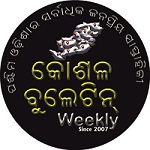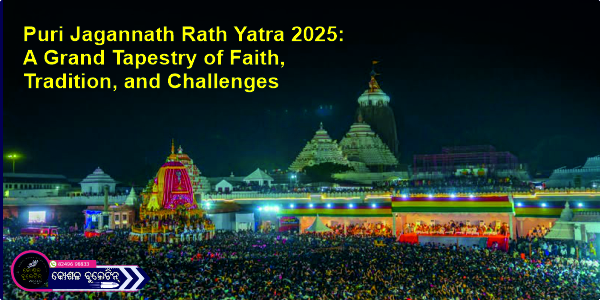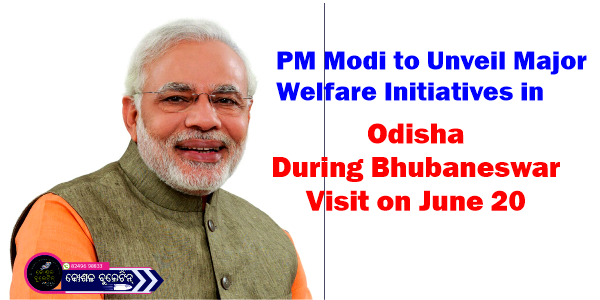The world famous Jagannath Rath Yatra, also known as the Car Festival or Shree Gundicha Yatra, commenced on June 27, 2025, in Puri, Odisha, transforming the coastal town into a vibrant epicenter of spiritual devotion and cultural splendor. This nine-day festival, one of the most revered in the Hindu calendar, draws over one million devotees from India and across the globe to participate in the sacred journey of Lord Jagannath, his elder brother Lord Balabhadra, and their sister Devi Subhadra. Housed in the iconic 12th-century Jagannath Temple, these deities are carried in a ceremonial procession to the Gundicha Temple, approximately 2.6 kilometers away, along the Bada Danda (Grand Road). Held annually on the Dwitiya Tithi of the Ashadha month’s bright half, the festival is steeped in mythological significance, rooted in scriptures like the Skanda Purana, which narrates Lord Jagannath’s journey to his aunt’s abode or birthplace. The event showcases Odisha’s rich heritage through intricate rituals, traditional craftsmanship, and communal participation, embodying a profound message of unity and devotion.
The festival began at dawn on June 27 with the Mangala Alati, a morning prayer ritual at 6:00 AM, setting a serene and sacred tone for the day’s events. This was followed by the Pahandi procession, a deeply moving ritual where the deities are carried from the temple’s sanctum sanctorum to their respective chariots. Adorned with vibrant cloth, gold ornaments, and floral decorations, Lord Jagannath, Lord Balabhadra, and Devi Subhadra were escorted by priests and servitors amid Vedic chants, the rhythmic beats of traditional instruments like mridang, kartal, and gongs, and the resounding chants of “Jai Jagannath” and “Hari Bol” from thousands of devotees lining the Grand Road. The Pahandi, known for its slow and deliberate pace, is a spectacle of devotion, with the deities’ movement symbolizing their divine descent to meet their devotees. This ritual, often lasting hours due to its ceremonial precision, evokes intense emotions, as devotees view it as a rare opportunity to witness the “Lord of the Universe” outside the temple’s sacred precincts.

A pivotal moment of the day was the Chhera Pahanra ritual, performed by Gajapati Maharaja Divyasingha Deb, the titular king of Puri and the chief servitor of Lord Jagannath. Dressed in traditional white attire and carried in a silver-plated palanquin, the Gajapati ascended each of the three chariots—Nandighosa (Lord Jagannath’s), Taladhwaja (Lord Balabhadra’s), and Darpadalana (Devi Subhadra’s)—to sweep their floors with a golden broom and sprinkle sandalwood-scented water. This act of humility, symbolizing equality before the divine, reinforces the festival’s core message that all are equal in the eyes of Lord Jagannath, a form of Lord Krishna revered as the universal deity. The ritual, watched by thousands, underscores the Gajapati’s role as the “first servitor,” blending royal tradition with spiritual devotion.
The chariots, the heart of the Rath Yatra, are a marvel of traditional engineering. Rebuilt annually by over 200 skilled artisans over 58 days, starting on Akshaya Tritiya, they are constructed from sacred wood sourced from the forests. Each chariot, weighing over 200 tonnes, is a towering structure adorned with intricate carvings, vibrant canopies, and symbolic motifs. Lord Jagannath’s Nandighosa, standing 45 feet tall with 16 wheels, is draped in red and yellow cloth; Lord Balabhadra’s Taladhwaja, with 14 wheels, is covered in red and green; and Devi Subhadra’s Darpadalana, with 12 wheels, is adorned in red and black. At 4:00 PM, thousands of devotees, gripping thick ropes, began pulling the chariots along the Bada Danda to the Gundicha Temple, a journey that can take hours due to the chariots’ weight and the massive crowds. For devotees, pulling the ropes or touching the chariots is a sacred act believed to grant spiritual merit and liberation from the cycle of rebirth, securing a place in Baikuntha, Lord Vishnu’s heavenly abode.
The festival’s scale necessitated extensive preparations by the Shree Jagannath Temple Administration and the Odisha government. Puri District Collector Siddharth Shankar Swain ensured robust infrastructure, including water stations, temporary shelters, and tourist amenities, to accommodate the influx of over one million pilgrims. The East Coast Railway operated 365 special trains from cities like Rourkela, Balasore, and Rayagada, while shuttle services connected parking hubs at Talabania, Malatipatapur, and Brahmagiri to key locations in Puri. Security was a top priority, with 10,000 police personnel, including eight companies of Central Armed Police Forces and National Security Guard units, deployed across the town. Over 275 AI-enabled CCTV cameras monitored the Grand Road and routes to Konark, while anti-drone teams ensured safety. A multi-agency mock drill near the Jagannath Temple tested emergency preparedness, and Puri Superintendent of Police Vineet Agarwal warned of strict action against unauthorized drone activity, allowing only “friendly drones” for surveillance.
Despite these efforts, the festival faced significant challenges. Extreme heat led to approximately 600 devotees being hospitalized for dehydration and heatstroke, prompting the Odisha government to deploy ambulances, first aid stations, and medical teams along the procession route. The Indian Red Cross Society contributed 100 volunteers to assist with crowd control, water distribution, first aid, and a lost-and-found service, with their efforts continuing until the Bahuda Yatra on July 5, when the deities return to the Jagannath Temple. Overcrowding exacerbated logistical issues, with hotels and lodges along the Bada Danda and seafront fully booked, forcing many devotees to sleep on the streets under intermittent drizzle, using free plastic sheets provided by companies for shelter. Sanitation was a major concern, with no temporary toilets built between the Jagannath Temple and Hospital Square despite a reported ₹3 crore allocation by the district administration and Puri Municipality. A private toilet, “Om Fresh,” near Bagala Dharmashala charged ₹80 for defecation and ₹20 for urination, leading to long queues and financial strain, particularly for women.
The Adani Group’s seva campaign, running from June 26 to July 8, provided significant relief by distributing nearly four million free meals and beverages to pilgrims, officials, and lifeguards through dedicated food counters. In collaboration with the Puri district administration, ISKCON, and local NGOs, the initiative also supported beach clean-up drives and the Puri Beach Lifeguard Mahasangha, focusing on removing plastic waste to maintain the coastline’s beauty. Municipal workers received safety jackets, volunteers were given free T-shirts, and devotees and officials were provided with raincoats, caps, jackets, and umbrellas to cope with the weather.
Cultural events enriched the festival’s vibrancy, with traditional Odissi dance performances captivating audiences and a stunning sand sculpture of 101 Lord Jagannath idols by artist Sudarsan Pattnaik on Puri Beach drawing widespread admiration. Dignitaries, including Odisha Governor Hari Babu Kambhampati, Chief Minister Mohan Charan Majhi, Union Ministers Dharmendra Pradhan and Gajendra Singh Shekhawat, and Puri MP Sambit Patra, attended the Pahandi procession, while the 145th Jagadguru Shankaracharya of Govardhan Math, Swami Nischalananda Saraswati, offered prayers atop the chariots, adding spiritual gravitas. The festival was broadcast live on DD Bharati at 8:30 AM on June 27, with All India Radio Cuttack featuring discussions with key figures like the Puri District Collector and the temple’s Chief Administrator, Dr. Arabinda Kumar Padhi, highlighting the meticulous planning involved.
The Odisha Crime Branch issued warnings about online hotel booking scams, urging pilgrims to report incidents to the Cyber Crime Helpline (1930). Despite these challenges, the Rath Yatra remained a profound expression of faith, with devotees enduring hardships to participate in rituals like the Hera Panchami on July 2 and the Bahuda Yatra on July 5. The festival, a testament to Odisha’s spiritual and cultural legacy, continues to inspire millions, blending ancient traditions with modern efforts to create a celebration of unity and devotion.




